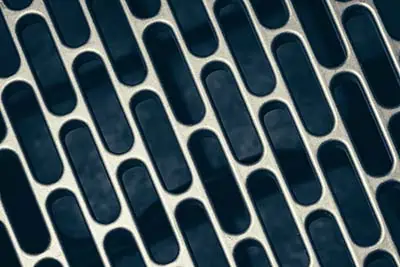Edge rounding (also known as edge radiusing) is the process of removing the vertical burrs, nibble marks, or scallops on the holes and edges of a deburred metal part. Metalworkers use edge rounding to break the edge of processed components, allowing for optimal coating coverage and corrosion protection.
As you might expect, there are a variety of metal solutions and systems your team can leverage for edge rounding. But which approach will work best for your shop’s unique needs? Today, we’ll explore that question by reviewing some of the fundamentals of metal edge rounding—including its core advantages and applications.
Why is Metal Edge Rounding Important?
Accurate rounding of metal parts plays an essential role across metalworking, namely to eliminate sharp edges and ensure strong adhesion of paints and coatings. Any sharp edges on metal parts will limit their available bonding surface—preventing proper application and bonding. This causes applied coatings and paints to peel off, resulting in corrosion and other issues.
Here’s a simple list of advantages that a metal rounding tool can bring to your metalworking projects:
Part Strength & Durability
Rounded metal parts will bond correctly with coatings, increasing their surface strength and durability in the process. (This is especially important for high-contact components.) Fully coated parts are more resistant to corrosion, operational wear and tear, abrasion, and many other types of damage.
Part Aesthetics
Rounding metal parts allows them to be properly coated and painted, creating functional products with an attractive aesthetic. Metal components free of sharp edges create a perfect bonding surface for paints, reducing the risk of peeling and being forced to reapply paint coatings over time.
Physical & Electrical Properties
Rounded metal parts are compatible with a wide range of protective coatings, including those that support electrical conductivity, heat resistance, and cryogenic stability. For these protective coatings to bond properly, each metal part must be completely free of burrs, scallops, and other surface imperfections.
Applications of Metal Edge Rounding
Metal edge rounding is a versatile process that can be used to support a variety of metalworking projects. Generally, this solution is ideal for creating the best possible finish on laser-cut, punched or machined metal parts. Edge rounding is a fast and efficient way to remove imperfections from parts with sharp edges or holes across many industries, ranging from automotive to healthcare.
One unique application of metal edge rounding is creating an ideal finish on parts with unique cosmetic requirements. For example, a modern edge rounding tool can round the edges of a stainless steel part without marring its surface or tearing off any protective sheeting.
Key Considerations for Metal Edge Rounding
Now that we’ve reviewed some of the general benefits and applications of metal edge rounding, let’s get into the specifics to help you find the best metal rounding tool for your shop:
Minimum Radius
Generally, a minimum radius of 2 mm is required when rounding the edges of metal parts. This standard is designed to ensure optimal adhesion for paints and coatings. At Apex Machine Group, our machines use oscillating discs equipped with abrasive sanding strips to break the edges of deburred metal parts—achieving an edge radius of up to 2 mm. [a]
Metal Edge Rounding Tools
Edge rounding can also be achieved with a variety of automated and hand-held tools, though the former are preferred for ideal efficiency and safety. For example, many dry metal machines can be equipped with multi-directional brushes to deburr and round off the edges of metal parts with a single pass. Some solutions are also equipped with rotatable heads, which can quickly alternate between edge rounding or deburring and heavy grinding.
Automated vs. Manual Edge Rounding
Many shops rely on a team of fabricators to deburr and round off metal parts using hand-held tools. And while this approach may seem simpler and less expensive at first glance, it actually creates major production challenges. First off, each fabricator has a different standard for deburring and rounding, creating inconsistencies throughout processed parts. These hand-held tools can also present safety risks for workers, ranging from repetitive strain injuries to cuts from handling unfinished parts.
Last but not least, manual edge rounding with hand-held tools can take hours of work. Compare this inefficient process to automated metal finishing machines (which can fully deburr and round out both sides of metal parts in seconds)—and it’s clear to see why leading metalworkers are investing in automation for long-term gains.
Combining Applications
Perhaps the greatest advantage of dry metal machines is that they can accommodate multiple applications across your job shop—including metal edge radiusing, deburring, dross removal, and dimensioning. For example, the Apex 1000 Series Dry Metal Machines can perform rust removal, deburring, and edge rounding in a single pass, bringing game-changing efficiencies and major ROI to your shop.
Get Started with Metal Edge Rounding Today
If you’re ready to find the perfect edge rounding tool for your metalworking shop, then be sure to contact Apex Machine Group today! Our application specialists will walk you through your team’s unique production needs—and work with you every step of the way to find a solution that matches your goals and budget.
[a]Minimum radius of 2 mm is required, then we say a “up to 2 mm is achievable.”
